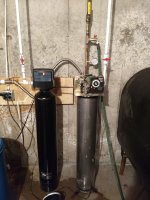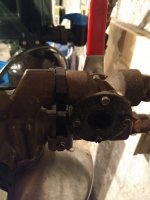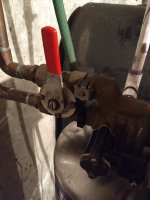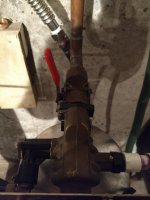Byron Willis
New Member
Hello there!
I just did some maintenance on my water softener (General Ionics EE0824, 8" X 44" tank, .75 cu ft resin). I cleaned, lubed, and reassembled the brine valve assembly, I replaced the resin, I cleaned the tank and the distributor, and I cleaned and lubed the bypass valve fittings.
After putting it back together, I found that there is a significant leak from the bypass assembly. My bypass valve body is all brass and then the head on my unit is all brass. There is a plastic fitting that has some O rings on it that goes between the brass (snugly inserts) and then there is a small metal clip that screws into the plastic and keeps the brass assemblies from separating (but doesn't exert any clamping force on the joint). I have a bad leak from where this plastic insert goes.
I have read that alignment is sometimes an issue, and I will try and modify my piping so that there is no excess force in any direction, but even still I suspect I will still have a leak. I suspect it's out of tolerance (either brass is out of round, O rings have lost their loft, hairline crack in plastic, etc).
I have looked into buying some other parts for my unit and discovered that they are very expensive and hard to locate. Anyone have some ideas on how to join these two fittings assuming I'm not able to replace the plastic doohicky? I'll probably start with replacement O rings, but I suspect I will still have an issue.
Cheers,
Byron
I just did some maintenance on my water softener (General Ionics EE0824, 8" X 44" tank, .75 cu ft resin). I cleaned, lubed, and reassembled the brine valve assembly, I replaced the resin, I cleaned the tank and the distributor, and I cleaned and lubed the bypass valve fittings.
After putting it back together, I found that there is a significant leak from the bypass assembly. My bypass valve body is all brass and then the head on my unit is all brass. There is a plastic fitting that has some O rings on it that goes between the brass (snugly inserts) and then there is a small metal clip that screws into the plastic and keeps the brass assemblies from separating (but doesn't exert any clamping force on the joint). I have a bad leak from where this plastic insert goes.
I have read that alignment is sometimes an issue, and I will try and modify my piping so that there is no excess force in any direction, but even still I suspect I will still have a leak. I suspect it's out of tolerance (either brass is out of round, O rings have lost their loft, hairline crack in plastic, etc).
I have looked into buying some other parts for my unit and discovered that they are very expensive and hard to locate. Anyone have some ideas on how to join these two fittings assuming I'm not able to replace the plastic doohicky? I'll probably start with replacement O rings, but I suspect I will still have an issue.
Cheers,
Byron




